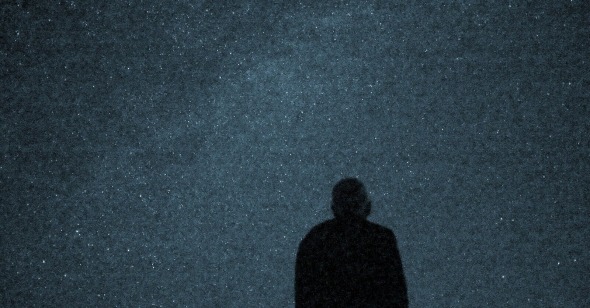To the Stars
By Conor Williams
Little, Big, and Far
Dir. Jem Cohen, U.S., Grasshopper Film
Since the 1980s, Jem Cohen has applied the anti-corporate, independent ethos of punk rock to his body of work as a filmmaker. His 1999 Fugazi documentary Instrument brought Cohen acclaim as a musician’s director. In more recent years, however, Cohen has made several documentaries, like his hypnotic 2015 feature Counting, as well as films that more subtly blend fiction and nonfiction, like 2012’s Museum Hours. Cohen visited my film studies class in college, and I remember him saying that with Museum Hours he had wanted to fool people—his producers, his actors, and his audience—into thinking he had made a narrative film, preferring to regard it as an observational documentary in disguise. Cohen’s films cannot be easily categorized, but what they do have in common is their originality, in which form usually comes first, and narrative second. As documentaries go, they are striking for their humanistic focus, and as narrative films go, they offer an uncommon clarity of setting.
Cohen’s latest, Little, Big, and Far, concerns Karl, an Austrian astronomer. Karl’s low, sonorous accented narration provides much of the film’s voiceover, as does the voice of his wife Eleanor (played by experimental filmmaker Leslie Thornton, who makes an on-screen appearance teaching students over Zoom). Little, Big, and Far is an epistolary film, and as Karl and Eleanor correspond with one another, we gather bits of context about their work. At the film’s beginning, Karl puts on a record: John and Alice Coltrane’s Cosmic Music, released in 1968 after John’s death. The music is searing, wailing. Karl associates this sort of music—the frenetic, organized chaos of free jazz—with the cosmos. And rightly so. The stars weren’t just a preoccupation of the Coltranes, but of other jazz legends too, like Pharaoh Sanders, and most notably Sun Ra and his Arkestra. As Cohen has attested through his work with musicians like R.E.M. and Elliott Smith, there’s a spiritual quality to music as well. A melody or a note contains as much mystery and magic as a prayer—or a star, or a moon, or anything in the great unknown of outer space.
Over footage of a mall parking lot where a crowd has gathered to witness an eclipse, Eleanor tells Karl about a hotel bar waitress who was curious about her work as a cosmologist. “She couldn’t believe we might go down some blind alley for ten years or a whole career and just get proven wrong,” she says, retorting, “The world isn’t what it seems to be anyway, it can be pretty interesting to have to take a whole new turn to look for some whole new reality.” Such is the delight of science, it’s often said—the possibility of being proven wrong, and the possibilities that “failure” then opens up. “Some blind alley” could be likened to the mystery of faith—there are those who believe, yet cannot know the ultimate truth.
In a way, Cohen has been looking “for some whole new reality” through his work. Eleanor recounts a story for Karl about a group of people waiting to see an eclipse. Through Cohen’s matter-of-fact camerawork, he lets the illusion of reality slip into the frame. Many scenes are patiently recorded and have the feeling of a documentary—I heard one cinemagoer leaving a press screening for the film expressing their shock at the end credits revealing the work of actors. Throughout, it is tricky to tell what’s real and what’s fiction. Much of the film’s action comes from its off-screen dialogue between Karl and Eleanor, although Little, Big, and Far could still stand to have more going on in terms of narrative, and perhaps less distance between Cohen’s protagonists.
At two hours, Little, Big, and Far might lull some viewers to sleep with its gentle tones and pitch-black skies. There are moments of sheer beauty—like when Cohen integrates images taken by the Rosetta space probe of the surface of a comet. They first flash on-screen at the beginning, under saxophone screams, and then again when Karl tells the story of the real-life European space mission and the sights it uncovered. “What looks like a solid cliff perhaps 100 meters high…is more like a tower of dust, a deception. What looks like the deadest pulverized rock…can be rich with organic molecules. What gifts comets carry… The snowlike trails are dust and cosmic rays; in the background, stars. It’s my favorite film of the last twenty years, maybe of my entire life.”
Such images brought to my mind the snow-blasted sets of Chaplin’s The Gold Rush, or what I saw after I hand-processed my own 16mm film in school. Perhaps what makes these scenes of space so profoundly beautiful and mesmerizing in a cinematic sense is that they realize Dziga Vertov’s 1923 theory of the Kino-Eye, “I am an eye. A mechanical eye. I am the machine that reveals the world to you as only the machine can see it. [...] Freed from the constraints of time and space, I organize each point of the universe as I wish. My route is that of a new conception of the world. I can make you discover the world you did not know existed.” By broadening his imagery to include those obtained from actual outer space, and placing it within the tapestry of his feature, Cohen suggests that modern cinema, unshackled from genre, is more powerful than we may give it credit for. Cohen’s work is porous, holding room for all these possibilities and more.
